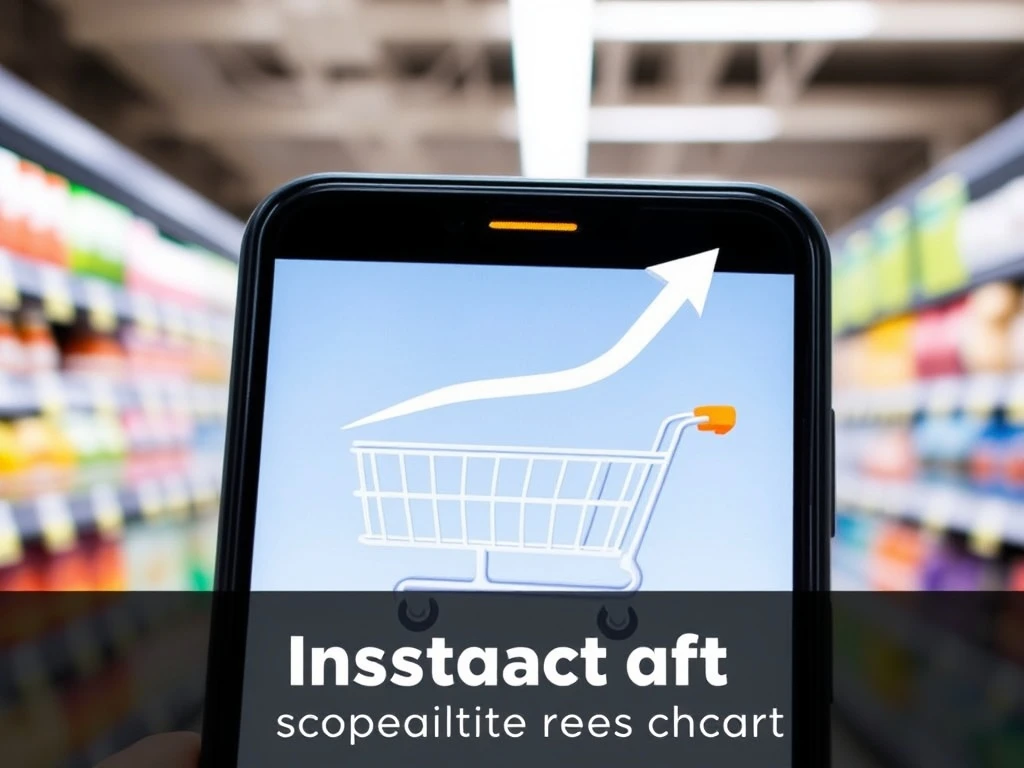Instacart, a leading online grocery platform, recently announced a significant shift. Its grocery partners are now increasingly adopting more competitive pricing strategies. This development coincides with Instacart’s demand forecast, which impressively topped earlier estimates. This indicates a pivotal moment for the company and the broader grocery delivery sector. Business leaders and entrepreneurs should note this strategic pivot.
The Evolution of Instacart Competitive Pricing
Instacart’s recent statement highlights a crucial trend among its retail partners. Retailers are embracing more aggressive pricing models. This move signifies a strategic adaptation to evolving consumer expectations. Previously, some online grocery prices often exceeded in-store prices. Now, the landscape is changing. Instacart competitive pricing aims to close this gap. This strategy benefits both consumers and retailers. It makes online grocery shopping more appealing. Furthermore, it helps partners attract and retain more customers. This strategic pivot reflects a mature market. Retailers recognize the need to compete effectively online. They understand that price is a significant factor for many shoppers.
- Increased market competition from other delivery services.
- Growing consumer demand for value.
- Retailers’ desire to expand their online customer base.
- Technological advancements enabling dynamic pricing.
This shift suggests a move towards parity. Online prices are becoming more aligned with in-store promotions. Consequently, consumers gain access to better deals. This fosters greater trust in the platform. Moreover, it encourages more frequent use of Instacart’s services. This proactive approach strengthens Instacart’s position. It also reinforces its commitment to its partners’ success.
How Partners Implement Competitive Pricing
Grocery partners are employing various tactics to achieve Instacart competitive pricing. Many are integrating their loyalty programs directly with Instacart. This allows shoppers to access in-store discounts online. Others are optimizing their inventory management. Efficient operations reduce costs. These savings can then be passed on to consumers. Furthermore, some partners are leveraging Instacart’s data insights. This helps them identify popular products. They can then price these items more strategically.
For example, a retailer might offer special online-only promotions. They might also provide bundled deals. These efforts collectively contribute to a more attractive pricing environment. Ultimately, this benefits the end-user. It also helps retailers boost their sales volumes. This collaborative effort demonstrates a shared vision. Both Instacart and its partners seek sustainable growth.
Instacart’s Demand Forecast Surpasses Expectations
Alongside the pricing news, Instacart reported robust demand. Its recent demand forecast significantly exceeded initial estimates. This strong performance underscores the platform’s resilience. It also highlights the growing consumer reliance on grocery delivery services. Several factors likely contributed to this surge. Firstly, the convenience factor remains paramount. Busy individuals and families increasingly value time-saving solutions. Secondly, the improved Instacart competitive pricing makes the service more accessible. Better prices naturally attract more users.
The increased demand is a positive indicator for Instacart. It suggests a healthy underlying business. It also provides confidence for future expansion plans. The company continues to invest in its technology. It also enhances its service offerings. This commitment supports sustained growth. Furthermore, the market for online grocery remains robust. Many consumers have permanently shifted their shopping habits. They prefer the ease of home delivery. This trend supports Instacart’s optimistic outlook.
Factors Fueling Robust Demand for Instacart
Several key elements are driving Instacart’s impressive demand figures. Primarily, consumer habit formation plays a major role. Many people adopted online grocery during recent global events. They found the service convenient and efficient. This behavior has largely persisted. Secondly, expanded service availability contributes significantly. Instacart continues to broaden its reach. It adds more retail partners and expands into new geographic areas. This makes the service accessible to more households.
Moreover, technological enhancements improve the user experience. Faster delivery times and more accurate order fulfillment boost satisfaction. Finally, the strategic adoption of Instacart competitive pricing by partners directly impacts demand. Lower prices make the service more appealing. This combination of factors creates a powerful growth engine. It ensures Instacart remains a top choice for online grocery. The company’s focus on user experience and affordability pays dividends.
Market Implications of Instacart’s Strategic Moves
Instacart’s embrace of competitive pricing and its surging demand have broader market implications. This trend could pressure other grocery delivery services. They may need to adjust their own pricing strategies. The market is becoming more competitive. Consequently, consumers stand to benefit from more affordable options. This dynamic also signals a maturation of the online grocery sector. Companies are moving beyond initial growth phases. They are now focusing on profitability and sustainability.
This shift might also influence traditional brick-and-mortar grocery stores. They could face increased pressure to offer competitive online options. Some may choose to partner more closely with platforms like Instacart. Others might invest further in their own delivery infrastructure. Ultimately, the consumer gains more choice. They also receive better value. This healthy competition drives innovation across the entire retail food industry. Instacart’s actions set a benchmark for others to follow.
The Impact on Retail Partners and Instacart Competitive Pricing
Retail partners working with Instacart are seeing tangible benefits. The adoption of Instacart competitive pricing helps them compete effectively online. It allows them to reach a wider customer base. This expands their market share. Furthermore, increased demand translates into higher sales volumes for these retailers. Instacart provides the technological backbone. It also offers the delivery network. This allows partners to focus on their core business: groceries.
The partnership model proves mutually beneficial. Retailers leverage Instacart’s platform. Instacart, in turn, strengthens its network. This symbiotic relationship fosters growth for both entities. It also positions them strongly against emerging competitors. Ultimately, the success of Instacart is intertwined with the success of its partners. Their shared commitment to value and service drives positive outcomes.
The Future Outlook for Instacart and Online Grocery
The current trends paint a positive picture for Instacart. Its strategic focus on Instacart competitive pricing and partner collaboration appears effective. The robust demand forecast reinforces this view. Looking ahead, the online grocery market will likely continue its expansion. Innovation in delivery logistics will also progress. This could include drone delivery or autonomous vehicles in the future.
Instacart’s ability to adapt will be crucial. It must continue to respond to consumer preferences. It also needs to maintain strong retailer relationships. The company’s emphasis on affordability and convenience positions it well. It can capture a larger share of the growing online grocery market. Furthermore, sustainability initiatives will become more important. Consumers increasingly prioritize environmentally friendly options. Instacart and its partners must consider these factors. They must innovate to stay ahead. The future of grocery shopping is clearly evolving online.
Conclusion:
Instacart’s recent announcements mark a significant turning point. Its grocery partners are actively embracing Instacart competitive pricing. This strategic shift directly contributes to rising consumer demand. The company’s forecast exceeding estimates validates its approach. This development benefits consumers through better value. It also empowers retailers to expand their online reach. As the online grocery landscape evolves, Instacart remains a key player. Its continued focus on affordability, convenience, and strong partnerships will shape its future success. This dynamic market promises continued innovation and growth for all involved.
Frequently Asked Questions (FAQs)
Q1: What does Instacart mean by “embracing more competitive pricing”?
A1: Instacart means its grocery retail partners are increasingly adjusting their online prices to be more in line with or even lower than their in-store prices and those of competitors. This includes integrating loyalty programs, offering online-exclusive deals, and optimizing operations to pass savings to consumers.
Q2: How does Instacart’s competitive pricing strategy benefit consumers?
A2: Consumers benefit by gaining access to more affordable online grocery options. They can find better deals, utilize their loyalty discounts, and ultimately save money on their online orders, making grocery delivery a more cost-effective and attractive choice.
Q3: Why did Instacart’s demand forecast top estimates?
A3: Several factors contributed to Instacart’s strong demand. These include the persistent consumer preference for convenience, expanded service availability, continuous technological improvements to the platform, and crucially, the adoption of more competitive pricing by its grocery partners.
Q4: What are the broader market implications of Instacart’s strategy?
A4: Instacart’s strategy could intensify competition among online grocery platforms, potentially leading to more competitive pricing across the industry. It also encourages traditional grocery stores to enhance their online offerings or deepen partnerships with delivery services, benefiting consumers with more choices and better value.
Q5: How does this affect Instacart’s retail partners?
A5: Retail partners benefit significantly. Instacart competitive pricing helps them attract and retain more online customers, increase sales volumes, and expand their market share without needing to build their own extensive delivery infrastructure. It allows them to leverage Instacart’s platform and network effectively.
Q6: What is the future outlook for Instacart in the online grocery market?
A6: The future outlook for Instacart appears positive. Its focus on affordability, convenience, and strong partner relationships positions it well for continued growth. The online grocery market is expected to expand further, and Instacart’s ability to adapt to evolving consumer preferences and technological advancements will be key to its sustained success.
























